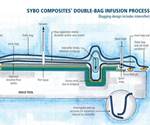Absolute vacuum gauge
The following is an excerpt from Issue 12 of The Composites Letter, published by www.vacmobiles.com (reposted here by permission) that outlines the importance of using an absolute vacuum gauge to measure pressure levels during double-bad infusion:“Often called a precision vacuum gauge, an absolute gauge actually works the opposite way to a conventional dial type vacuum gauge.
The following is an excerpt from Issue 12 of The Composites Letter, published by www.vacmobiles.com (reposted here by permission) that outlines the importance of using an absolute vacuum gauge to measure pressure levels during double-bad infusion:
“Often called a precision vacuum gauge, an absolute gauge actually works the opposite way to a conventional dial type vacuum gauge. The latter measures the pressure differential below the atmospheric pressure surrounding the gauge. An absolute pressure gauge measures the actual pressure above the absolute zero of pressure. Using the absolute zero of pressure as a reference provides far more accurate measurements of vacuum levels for high-quality infusion and prepreg laminating, because it is a fixed point of reference uninfluenced by environmental factors. The atmospheric pressure reference point used by dial type vacuum gauges varies widely with changes in weather and geography. A good quality oil lubricated vacuum pump suitable for high quality vacuum infusion or prepreg work will achieve an absolute pressure of 10 mbar to 20 mbar above the absolute zero of pressure at the pump. It is not uncommon for this type of pump to achieve absolute pressures in the vacuum bag in the 20mbar to 30mbar range. In order to confirm that a bag has been evacuated to this degree of vacuum, the gauge used needs to be accurate in this region. This is practically impossible for conventional dial type gauges, which will experience inaccuracies of at least ±25 mbar from weather variations alone, plus those due to the mechanism within the gauge, typically between 1 and 3 percent of full scale, adding perhaps another ±30 mbar of error. Thus, a vacuum gauge with a total accuracy of ±55 mbar is not appropriate for measuring an in-bag vacuum of 10 to 30 mbar.”
Related Content
-
Plant tour: Daher Shap’in TechCenter and composites production plant, Saint-Aignan-de-Grandlieu, France
Co-located R&D and production advance OOA thermosets, thermoplastics, welding, recycling and digital technologies for faster processing and certification of lighter, more sustainable composites.
-
Hexagon Purus Westminster: Experience, growth, new developments in hydrogen storage
Hexagon Purus scales production of Type 4 composite tanks, discusses growth, recyclability, sensors and carbon fiber supply and sustainability.
-
Recycling hydrogen tanks to produce automotive structural components
Voith Composites and partners develop recycling solutions for hydrogen storage tanks and manufacturing methods to produce automotive parts from the recycled materials.










.jpg;maxWidth=300;quality=90)

